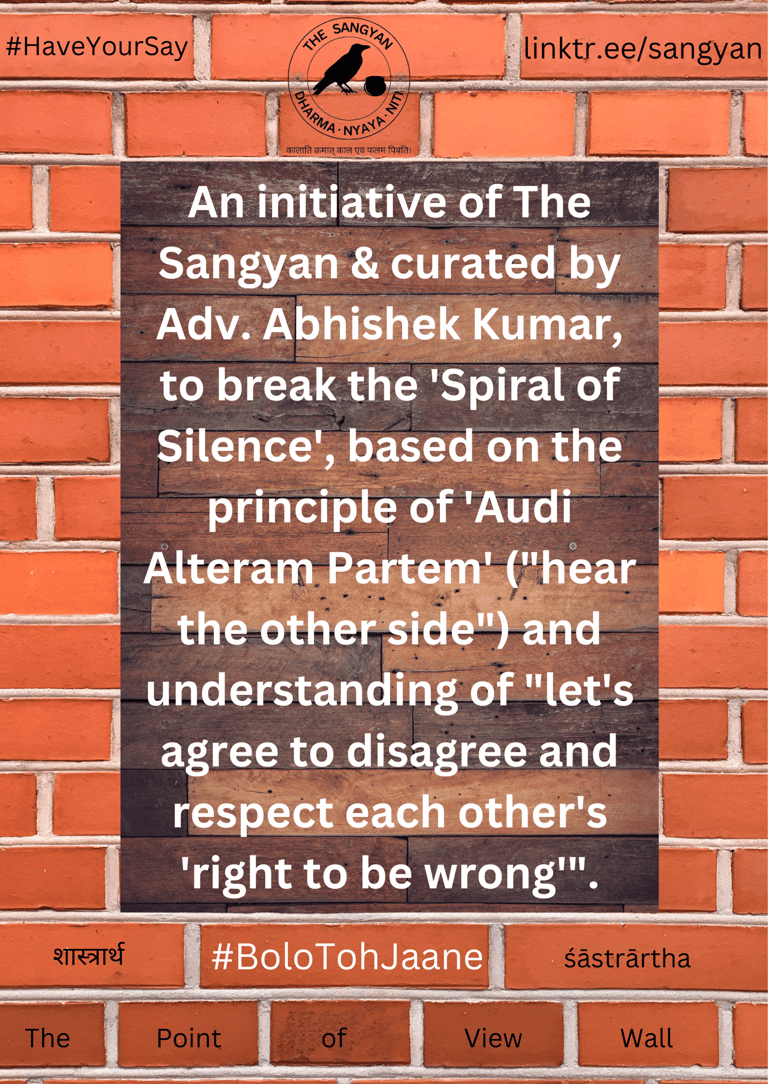

Project Bolo Toh Jaane
Audi Alteram Partem
#BoloTohJaane - An initiative of The Sangyan and curated by Adv. Abhishek Kumar, to break the 'spiral of silence', based on the principle of 'Audi Alteram Partem' ("hear the other side") and understanding of "let's agree to disagree and respect each other's 'right to be wrong'".
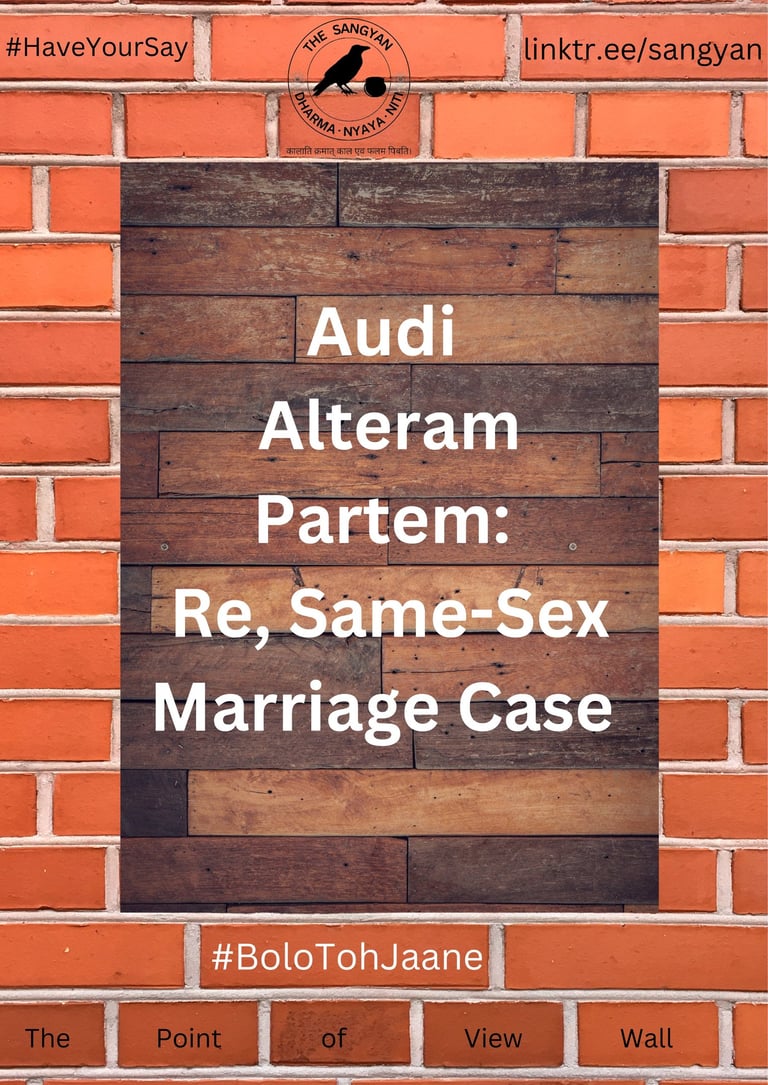

Article 50 of the Constitution of India provides for the “Separation of judiciary from executive. — The State shall take steps to separate the judiciary from the executive in the public services of the State.”
In Kesavananda Bharti vs. State of Kerala, Hon’ble Chief Justice Sikri observed: “Separation of powers between the legislature, the executive and the judiciary is a part of the basic structure of the Constitution; this structure cannot be destroyed by any form of amendment.” [AIR 1973 SC 1461 at page no. 1535].
In essence, in my opinion, the Supreme Court of India did the right thing by not giving effect to ‘Judicial Overreach’ (when the courts are not merely interpreting the law but rather start legislating the law) and passed the baton to the Parliament of India (the right and just constitutional forum to address the issue having legal, social and political dimensions).
The appropriate constitutional mechanism and process will ensure the ‘Triple Chain of Accountability’ [Permanent and Temporary Executive (Bureaucracy and Government) answerable to Parliament/Legislative Assembly, who in turn are accountable to the Will of People (We, The People of India)] and ergo, will deliver a more sustainable change.
For reference, CJI Chandrachud had stated, “this Court would in effect be redrafting the law(s) in the garb of reading words into the provisions”, essentially violating the doctrine of separation of powers”. Additionally, agreeing with Justice Bhat, Justice Narasimha had stated that “mandating the state to recognise a civil union, would violate the doctrine of separation of powers”.
Case in Point: Supriyo @ Supriya Chakraborty & Anr. vs Union of India | 2023 INSC 920 | Writ Petition (Civil) №1011 of 2022 | https://main.sci.gov.in/supremecourt/2022/36593/36593_2022_1_1501_47792_Judgement_17-Oct-2023.pdf
For more click the link: Bolo Toh Jaane — Audi Alteram Partem: Re, Same-Sex Marriage Case
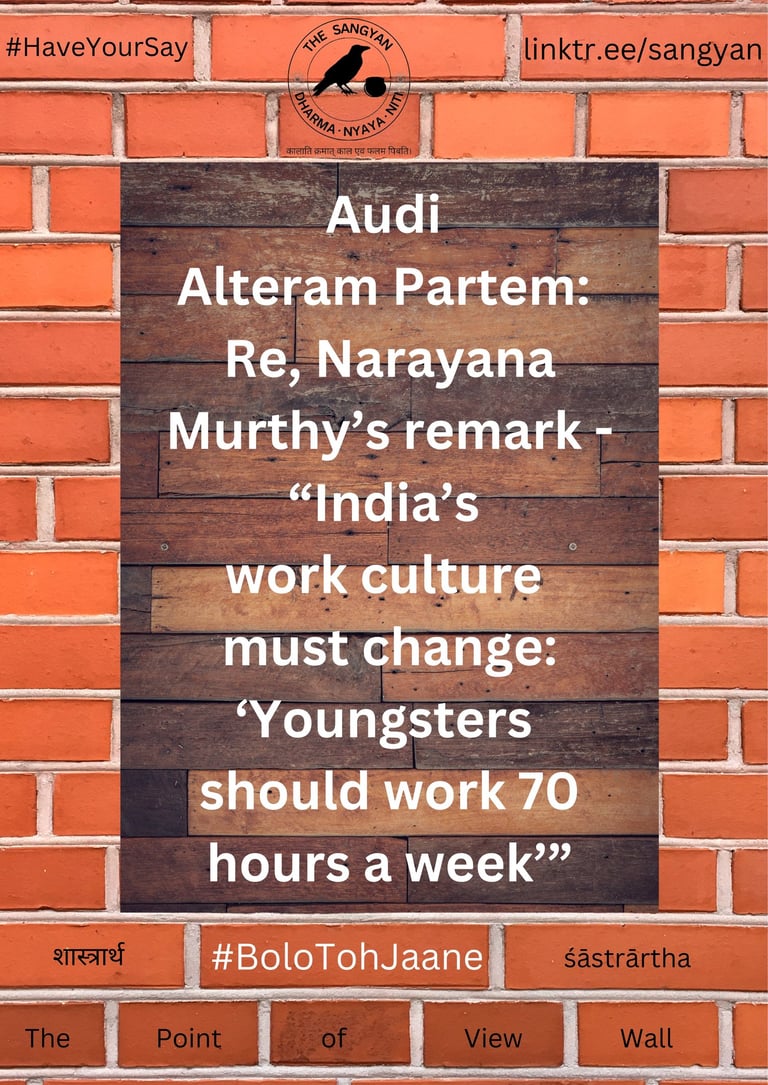

Headlines can be misleading, so you better read and listen in toto before jumping the gun, be it regarding what Narayan Murthy has to say or me. [Let’s focus on the deeper discussion rather than superficial debates and miss the forest for the trees]. The Record | Leadership by Example — Episode 1 | Narayana Murthy x T.V. Mohandas Pai. The International Labour Organization Convention prescribes eight hours of work for six days a week with a cap of 48 hours of work in a week. India ranks 5th in the world among countries with long working hours, often stretching up to 48 hours a week, if not more. Only Gambia, Mongolia, Maldives and Qatar, where a quarter of the population is Indian, have average working hours longer than in India. [FirstPost and ILO]. Given a choice between ‘all work and no time and all time but no work’. The latter often is the better. The higher the value chain of production, the more the quality of hours matters than merely the quantity of working hours. However, in case one is willing to work for long hours for whatever reasons (passion, financial needs, etc.), then the compensation/remuneration must be proportional to the input. If and when not, then one can only pretend to work (for money and other materialistic benefits) and not actually work with the mind in the right place. And that will backfire in the long run despite its initial benefit with multiple externalities acting together and creating a deadweight loss for society. Indeed, work productivity is different from working hours, and India needs to put in extra hours of productive work (in terms of quality and not just quantity) to compete globally — as Japan and Germany did after World War II, given the global economic and financial realities with China [“The World’s Factory”] and other economies offering competitive returns of investment with substantively lower logistical costs, and thus having a comparative advantage over India, that is Bharat. The ideas of Protestant Work Ethic [In sociological theory, Protestant ethic is the value attached to hard work, thrift, and efficiency] and the Spirit of Capitalism formed the basis of the ‘American Dream’. India, too, has its moral and constitutional obligation for development as a means to freedom from poverty. [Development As Freedom]. The work culture must respect and adhere in accordance with the Puruṣārtha [four proper goals or aims of human life]: Dharma (righteousness, virtue, duty, moral values), Artha (wealth, prosperity, economic values), Kama (pleasure, love, psychological values), and Moksha (freedom, liberation, spiritual values, self-actualisation). Otherwise, it’ll be futile in the long run, given the various orders of impact of any such laws and/or policies that evens out the initial benefits. Similarly, the Japanese concept of Ikigai (‘a reason for being’) helps in the realisation of a person’s sense of purpose and a reason for living [What You Love (Passion), What You Are Good At (Profession), What You Can Be Paid For (Vocation), and What The World Needs (Mission)] which may be a useful way to explore and balance lifestyle. For more, click the link here.

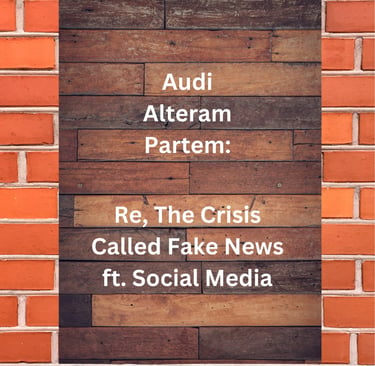
Is our public discourse backsliding with the advent of social media?
Just like the Samudra Manthana, Social Media has also produced both Amritand Halāhal — both in general to public discourse and specific to mass communication/journalism. Social media platforms have resulted in the ‘democratization’ of information and narrative away from the monopoly of legacy media and controlled journalism (by government, deep state and certain ideologies/pressure groups) and have created conditions for much more diverse points of view and citizen journalism (public citizens “playing an active role in the process of collecting, reporting, analyzing, and disseminating news and information”) and other multiplier effects.
So, the internet and social media platforms, even though they have created space for propagating fake news, have also ensured scope for real-time fact-checking and counter-narratives (for instance, X/Twitter’s Community Notes feature) and make credibility a high virtue, be it for an individual or an organization. And given the strange time we are living in, it will only ensure more and more echo chambers and less and less room for Shastrartha.
However, in my limited understanding, to second what Elon Musk stated, AI is a “threat to humanity”, and the negative impacts of AI with respect to Deep Fakes and algorithm-based fifth-gen information and psychological warfare are already exposing the dark realities of our times and maybe we’re just moving towards realizing “Fermi paradox”.
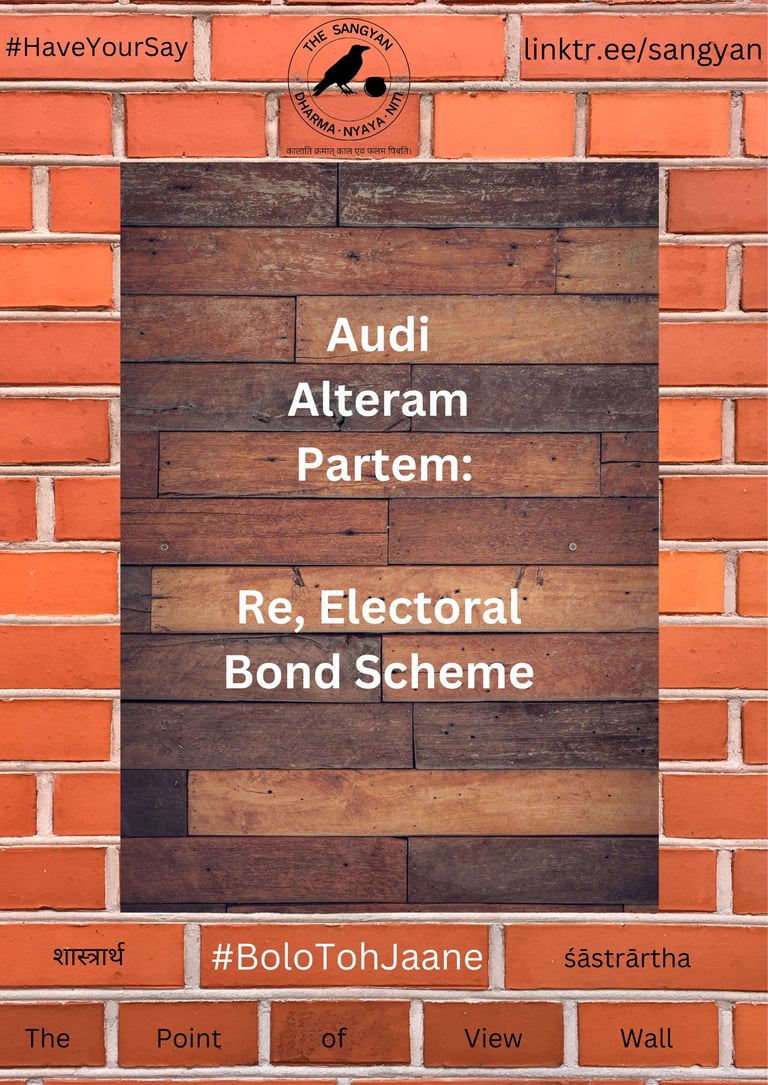

In essence, the Supreme Court of India in the Electoral Bond Scheme case, struck down the Electoral Bonds, citing violations of the voters’ right to information and potential quid pro quo (favours in return for funding). This sounds fine, right? Indeed, but does this decision improve the status quo concerning political finance in India? In my limited understanding, this judgment rather than helping the cause of curbing black money and ensuring transparency and accountability in political funding, damages the very goal.
Arun Jaitley proposed the scheme while presenting the Union Budget for the 2017–18 fiscal year and stated that the scheme was “an effort to cleanse the system of funding of political parties” by providing an alternative to cash donations (the primary mode of political funding).
Section 7 (4) and (5) of the Electoral Bond Scheme provided for “The information furnished by the buyer shall be treated confidential by the authorised bank and shall not be disclosed to any authority for any purposes, except when demanded by a competent court or upon registration of criminal case by any law enforcement agency.” and “(5) A non-Know Your Customer compliant application or an application not meeting the requirements of the scheme shall be rejected.” These provisions do provide certain safeguards for transparency and accountability in political funding as per the procedure prescribed by the law. Electoral bond transactions have a footprint/trail with it mentioned in the balance sheet of both the donor as well as the receiving political parties.
For more, click the link here.
When the scheme was introduced, all major political parties encashed the electoral bonds and benefitted from the scheme. The argument that the party in government disproportionately benefitted from the scheme doesn’t hold true as the absolute number doesn’t hold legitimacy. To understand, let’s explore using the thought experiment of India being the fifth-largest economy and above Switzerland, but that doesn’t mean India is better off when compared to Switzerland economically as the better parameter to compare the two economies is per capita income wherein India still is a developing nation while Switzerland is a developed counterpart. Similarly, when assessing the funding from the electoral bond scheme, it must be taken into account while putting the context of the number of MPs and MPLs of every political party and certain regional political parties received more per public representative through electoral bonds when compared to even national parties. Indeed, the scheme doesn’t perfectly qualify the test of least restrictive means and is flawed yet was a better step as it’s not that corporate giants like Tata, Reliance, and Adani, didn’t do any political funding — but probably preferred other avenues to carry out the political funding.
The Election Commission of India opposed the Electoral Bond Scheme, citing concerns about transparency in political finance and concerns regarding how the scheme could prevent information regarding foreign funding from coming out, “which could lead to Indian policies being influenced by foreign companies.” This is a valid concern that must be addressed by envisioning innovative mechanisms given the complex ownership and management of corporate companies.
The apex court struck down the electoral bond scheme primarily on the grounds of transparency, which though in principle does hold ground but we need to be pragmatic enough to understand good is not the enemy of ideal. The Electoral Bond Scheme is definitely not perfect but is indeed an upgrade on the situation of political funding before the introduction of the scheme and at present after the Supreme Court of India’s decision, wherein the political finance will return to the black money vulnerable cash deposits.
This decision also harms India’s Sovereign Guarantee of Anonymity to ensure there’s no political vendetta against the donors if and when they contribute or fail to contribute to certain political parties. The retroactive effect (when a law or decision comes into effect from a date before it was approved) of disclosure of electoral bond buyers (privacy of donors) damages the sovereign guarantee of the state having multiple order impacts, including rule of law and business confidence.
In conclusion, much like the NJAC verdict over the appointment of judges and the Collegium system, the apex court has done more damage than good. It should have chosen the path of strucking down certain specific provisions of contentions (and that too with proactive effect) rather than the whole act or scheme as the case may be. Remember, perfect isn’t the enemy of good! Rather than curbing the black money in political funding, it’ll harm the endeavour of ensuring transparency and accountability and actually result in promoting black money in political finance.
Moreover, the same rationale of transparency and accountability shall apply to the judiciary that fails to walk the talk when it comes to transparency and accountability, be it with respect to the Collegium system of appointment of judges by the judges themselves (which too is a violation of the citizen’s right to information about the grounds of selection/rejection and potential quid pro quo) and the declaration of assets of the judges which continues to remain unknown. PS, do check out the Assets of Hon’ble Judges of the Supreme Court of India
[https://main.sci.gov.in/assets-judges] Surprised, right? And yes, your internet connection is working fine.
Now the ball is back to the turf of the Parliament of India to discuss, deliberate, draft, and legislate another law and policy framework that’s an upgradation to the previous electoral bond scheme and takes into account the concerns raised by the Election Commission of India, Supreme Court of India and We The People of the Republic of India, in order to ensure transparency and accountability in political funding while upholding the rule of law, privacy concerns, and confidence of businesses.
Sources and References -
Electoral Bond Scheme 2018 Gazette Notification №20 dated 02nd January 2018 [https://www.scobserver.in/wp-content/uploads/2021/10/Electoral-Bonds-Scheme-2018.pdf]
Association for Democratic Reforms & Anr. vs Union of India & Ors.; 2024 INSC 113; (Electoral Bond Scheme Judgment) [https://main.sci.gov.in/supremecourt/2017/27935/27935_2017_1_1501_50573_Judgement_15-Feb-2024.pdf]
Constitutionality of the Electoral Bond Scheme — Electoral Bond Scheme Case Brief [https://www.scobserver.in/cases/association-for-democratic-reforms-electoral-bonds-case-background/]
SC strikes down electoral bonds: Full timeline and scheme explained [https://www.business-standard.com/elections/lok-sabha-election/sc-strikes-down-electoral-bonds-full-timeline-and-scheme-explained-124021500665_1.html]
Electoral bonds data | Retrospective ‘who paid whom’ order has grave impact: Industry bodies [https://indianexpress.com/article/india/electoral-bonds-data-retrospective-who-paid-whom-order-has-grave-impact-industry-bodies-9221593/]
Contact Us
abhishek.thesangyan@gmail.com (Founder) thesangyan.in@gmail.com (Organization) Linktree: https://linktr.ee/sangyan and
https://linktr.ee/thesangyan
